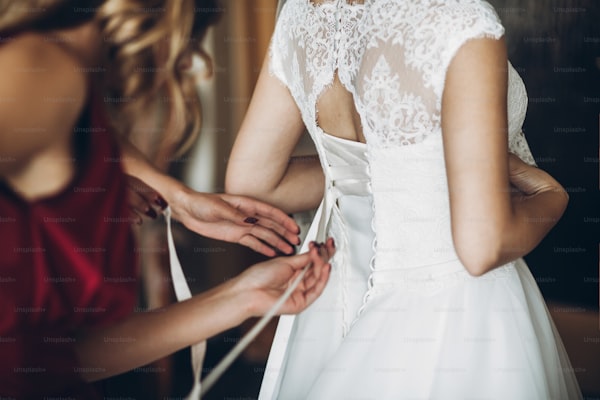Expert Guide: Handling Fitting Adjustments for a Wedding Dress with Extensive Beading
Understanding the Complexity of Wedding Dress Fittings
Choosing the perfect wedding dress is a significant and emotional decision for any bride. However, once you find that dream dress, the journey isn't over yet. One of the crucial steps is ensuring that the garment fits perfectly, especially when the dress features extensive beading. In this article, we’ll explore how to effectively handle fitting adjustments for a wedding dress with extensive beading, ensuring that you look stunning on your special day.
The Importance of Fitting in Wedding Attire
Wedding dresses, particularly those embellished with intricate beading, require precise fitting to maintain their elegance and structure. Here are some reasons why fitting is critical:
- Comfort: A well-fitted dress allows for easy movement, ensuring that you can enjoy your wedding day without discomfort.
- Style Integrity: Extensive beading adds weight to the fabric, affecting the dress's silhouette. Proper fitting preserves the original design.
- Confidence: Wearing a dress that fits perfectly boosts your confidence and allows you to shine on your big day.
Challenges of Altering Beaded Wedding dresses
Making adjustments to a wedding dress loaded with beads presents unique challenges. Here are some factors to consider:
- Time Consumption: Alterations may take longer due to the careful handling of beading.
- Cost Implications: Extensive alterations could lead to higher costs. It's essential to budget for both the dress and any necessary adjustments.
- Skill Requirement: Not all tailors have experience working with heavily embellished fabrics. Finding a skilled professional is crucial.
When to Start Fitting Adjustments
Timing is everything when it comes to wedding dress fittings. Here’s a timeline to consider:
| Fitting Stage | Recommended Timeframe | Notes |
| First Fitting | 3-4 Months Before the Wedding | Allows ample time for multiple adjustments. |
| Second Fitting | 1-2 Months Before the Wedding | Refines fit and addresses any issues. |
| Final Fitting | 2-3 Weeks Before the Wedding | Ensures the dress is ready for the big day. |
Steps to Handle Fitting Adjustments
To make fitting adjustments manageable, follow these steps:
1. Choose an Experienced Tailor
Select a tailor with experience in bridal wear, specifically with beaded garments. Ask about their previous work and seek reviews from brides who had similar dresses altered.
2. Assess the Initial Fit
During your first fitting, discuss your vision with the tailor. Point out any areas of concern and discuss how the dress should fit to achieve the desired silhouette.
3. Communicate Openly
Communication is key. Clearly articulate what adjustments you wish for and the level of comfort you require. If you're unsure, seek the tailor's professional advice.
4. Schedule Multiple Fittings
Since beaded dresses can be complex, multiple fittings may be necessary. Schedule these well in advance to allow for any unforeseen challenges.
5. Handle Beading with Care
When making adjustments, the tailor will approach the beading with caution. They may need to detach beads or work around them to avoid damage.
Specific Adjustment Techniques for Beaded Dresses
Here’s how some common adjustments can be performed on beaded dresses:
Hem Adjustments
When shortening the length of a beaded dress, the tailor will likely remove beads from the hemline before cutting the fabric. Post alteration, they will reattach the beads, ensuring the design remains intact.
Bust Adjustments
If the bust area requires adjustments, the tailor must ensure that the beading aligns correctly along the seams. This might involve repositioning beads for uniformity.
Side Seam Adjustments
For taking in or letting out the dress at the side seams, beading might need to be adjusted at these points as well. The tailor must balance the design while ensuring comfort.

What to Avoid When Fitting Beaded Wedding dresses
To ensure a successful alteration process, keep the following points in mind:
- Avoid Last-Minute Changes: Making drastic changes close to the wedding day can result in rushed jobs or mistakes.
- Don’t Skip the First Fitting: This initial fitting is crucial for assessing major adjustments.
- Be Cautious with DIY Adjustments: Unless you're experienced with sewing, it's best to avoid self-alterations to prevent ruining the dress.
Conclusion: Perfecting Your Wedding Dress Fit
Handling fitting adjustments for a wedding dress with extensive beading requires foresight, preparation, and skilled craftsmanship. By following the guidelines laid out in this article and communicating clearly with your tailor, you’ll ensure a perfect fit that enhances your beauty on your special day. Remember to start the fitting process early to accommodate any unexpected challenges. A well-fitted gown will not only look amazing but also help you feel confident and comfortable as you walk down the aisle. Happy planning!